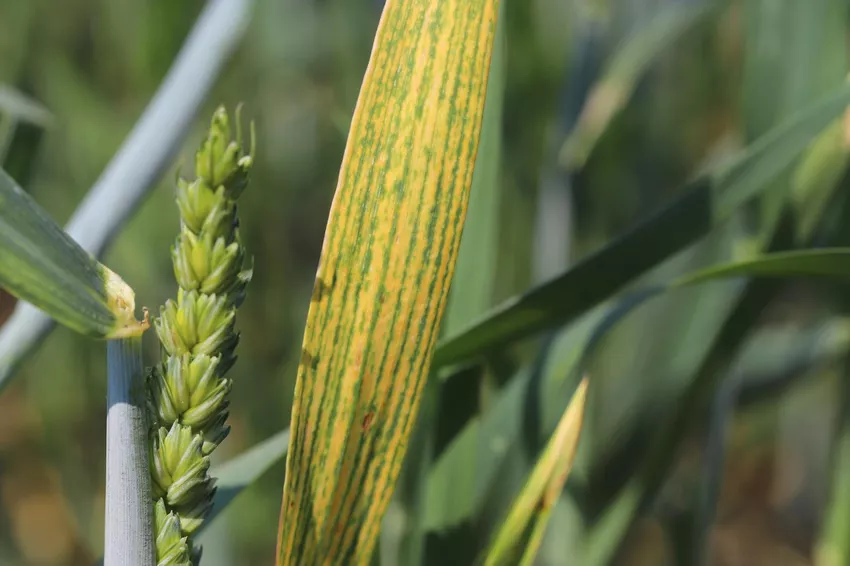Often the soil does not contain enough magnesium for the plants that grow in it. Here you can find out how magnesium fertilizer works and is used.

Magnesium deficiency can occur both in the garden and in potted plants. Such is not so easy to recognize - so we show what magnesium fertilizer is, why the plant needs magnesium and in which cases magnesium fertilizer is used.
Magnesium fertilizers are called the fertilizers that are mainly used to fertilize magnesium. The mineral fertilizer s alts are always present in combination with other nutrients, you will not find pure magnesium on the fertilizer shelf. Conversely, magnesium is partly a component of other fertilizers that are actually distributed to cover a different need - it is, for example, a secondary component of Thomas phosphate (Thomas flour). Examples of magnesium fertilizers are kieserite (MgSO4), Epsom s alts (MgSO4) and dolomite (CaCO3 -MgCO3).
Why do plants need magnesium?
Magnesium is vital to all plants. 20% of the magnesium contained in plants is embedded in the chlorophyll as a central atom - without magnesium, no photosynthesis can take place and no energy can be generated. If the plant suffers from a slight magnesium deficiency, the photo systems are given preferential treatment first. All other places where the ion is actually needed remain underoccupied. Because magnesium also controls the activity of many enzymes involved in cell respiration and the formation of ATP (adenosine triphosphate), problems quickly arise: the root is insufficiently nourished and a poorly nourished root then leads to malnutrition along with all the others Nutrients.
Magnesium Deficiency Symptoms
A little later, yellow chlorosis appears on the foliage of the undernourished plant. The leaves turn yellow starting from the middle of the leaf, the leaf veins and the edge remain green the longest. All symptoms first appear on older leaves - this is how the magnesium deficiency can be clearly distinguished from the optically similar iron deficiency.In addition, heavily exposed leaves show symptoms earlier than leaves in the shade. Incidentally, chlorosis appears in a different way on grasses: they are punctiform and are therefore called “chain of pearls” in technical jargon. In conifers (conifers), the yellowing begins at the tip of the needle - also first on the oldest needles and therefore unfortunately often inside the plant.

How does magnesium fertilizer work?
Magnesium can be introduced into the soil in the classic way or fertilized as a foliar fertilizer. However, the latter is only recommended if a severe, acute deficiency is to be remedied, since magnesium can diffuse into the leaf quite quickly, but not in large quantities. Magnesium is taken up from the soil as Mg2+ dissolved in the water by mass flow - so there are no special transport proteins on plant roots.
Application of magnesium fertilizer in the garden
Not so few soils lack magnesium - sandy and acidic soils are particularly often affected. Above all, (former) grazing land of hoofed animals is often depleted of magnesium because they have a high magnesium requirement and cover it with the grazing grass. The magnesium content of your soil can be determined via soil tests and a fertilizer recommendation can be made. In the case of strong magnesium deprivation, around 5 kg of pure magnesium can be extracted from 1000 m2 soil every year - especially if the cuttings or harvested material are removed. In the home garden, however, such high withdrawals are not the rule. If magnesium needs to be fertilized, you can choose between short and long-term fertilizers. We have listed possible fertilizers for you in the table below.
| Magnesium Fertilizer | Magnesium Content (% MgO) | Effect |
|---|---|---|
| Epsom S alts | 16 | Fast, also foliar fertilization, + sulphur |
| Kieserite | 27 | Fast, + Brimstone |
| Dolomite | Approx. 20Slow, + Calcium | |
| Kalimagnesia | 10 | Fast, + Potassium, + Sulfur |
Fertilizer manufacturers indicate the magnesium content as MgO (magnesium oxide). So if you want to know how much fertilizer you need to spread to apply a certain amount of pure magnesium, you can multiply the value in MgO by 0.603. This gives you the pure magnesium content.
Example:
10 kg Epsom s alts contain 16% MgO. 16 x 0.603=9.6% pure magnesium. So there are about 10%, i.e. one kilogram, of the 10 kg Epsom s alt is actually pure magnesium.
Fertilization recommendation for magnesium
If your garden shows untypically high withdrawals or deficiency symptoms, or if soil analysis shows a clear deficiency, we recommend magnesium fertilization with one of the special fertilizers mentioned above. In many cases, however, primarily organic fertilization and subsequent supply from the soil is sufficient to cover the demand. Our Plantura organic hydrangea fertilizer and our Plantura organic rose fertilizer also contain an extra portion of magnesium, so they can make all the difference with plants that consume a lot of magnesium, such as legumes, almonds or oats.